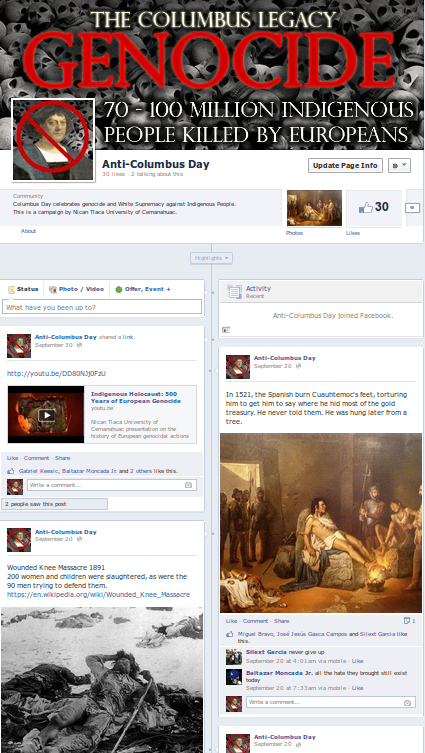DISCLAIMER: Nican Tlaca University of Cemanahuac (NTUC) does NOT EVER speak for or represent ANY other organization, including -- but not limited to: Brown Berets, CASA, Chicano Movement, Congressional Hispanic Caucus, Danza Azteca, Latinos Unidos, LULAC, MAPA, MEChA, Mexica Movement, Nation of Aztlan, National Council of La Raza, Raza Educators, Raza Unida, Semillas Del Pueblo, American Indian Movement, Society of Mexican American Engineers and Scientists, etc.
Sunday, November 3, 2013
Statement of Disassociation from Other Organizations
Nican Tlaca University of Cemanahuac (NTUC) is NOT associated with ANY OTHER organization.
No other organization speaks for Nican Tlaca University of Cemanahuac (NTUC).
Nican Tlaca University of Cemanahuac (NTUC) does NOT EVER speak for or represent ANY other organization, including -- but not limited to:
Brown Berets, CASA, Chicano Movement, Congressional Hispanic Caucus, Danza Azteca, Latinos Unidos, LULAC, MAPA, MEChA, Mexica Movement, Nation of Aztlan, National Council of La Raza, Raza Educators, Raza Unida, Semillas Del Pueblo, American Indian Movement, Society of Mexican American Engineers and Scientists, etc.
None of these groups are affiliated with Nican Tlaca University of Cemanahuac (NTUC), nor does Nican Tlaca University of Cemanahuac (NTUC) communicate with any of these groups.
The views published on Nican Tlaca University of Cemanahuac (NTUC) solely reflect those of the author -- whether or not they agree or disagree with the perspectives of others.
Nican Tlaca University of Cemanahuac (NTUC) is not associated with any other group whatsoever.
Nican Tlaca University of Cemanahuac (NTUC) does not solicit donations or any type of revenue. All activities are strictly for sharing academic information and history, which is a 100% legal right. See https://www.aclu.org/free-speech/freedom-expression#2
To see a list of academic sources used by Nican Tlaca University of Cemanahuac (NTUC), visit:
http://nicantlacauniversity.blogspot.com/2013/11/academic-origins-of-major-ideas-with.html
Notice
http://nicantlacauniversity.blogspot.com/2013/11/academic-origins-of-major-ideas-with.html
Academic Origins of Major Ideas (with academic citations)
Academic Origins of Major Ideas
(with academic citations)
The term Nican Tlaca has been a part of the historical record for nearly 500 years.
A small segment from page 641 of James Lockhart's 1992 book showing Nican Tlaca as being equated with a “term for indigenous people”. (Lockart would assert the same meaning to Nican Tlaca in his next book in 1993).
3. James Lockhart (1993)
Seen above: a small segment from page 331 of James Lockhart's 1993 book showing Nican Tlaca as being equated with a “term for indigenous people”.
“Likewise the natives did not call themselves Indians, and in fact it was not until nearly a half century after the conquest that any term arose to describe the natives to themselves, usually appearing as Nican Tlaca [emphasis added]” (Schwaller, 1993, p. 762).
In his book Our Lady of Guadalupe: The Origins and Sources of a Mexican National Symbol 1531-1797, historian Stafford Poole notes that the term Nican Tlaca was being used well into the 1600s. In particular, the term shows up in a written account of "Indian miracles" claimed to come from "The Virgin":
"The story of the Indian miraculously restored to life at the time of the dedication parade contains no Spanish loan words and uses the older term nican tlaca for natives (Poole, 1995, p. 122).(Note: Poole's book deals with "La Virgen de Tepeyac" and debunks the entire "Juan Diego appearance" story by showing how no official records exist for the story with the local Catholic Bishop during the years the event was claimed to occur.)
Also in 1995, in his review of James Lockhart's book We People Here: Nahuatl Accounts of the Conquest of Mexico, Poole makes a reference to the usage of the term Nican Tlaca:
“The "people here" (nican tlaca) also showed relatively little interest in the Spaniards as such” (Poole, 1995, p. 225).
8. Susan Schroeder (2010)
Describing the Colonial-era historian Chimalpahin in The Conquest All Over Again: Nahuas and Zapotecs, Thinking, Writing, and Painting Spanish Colonialism, Susan Schroeder remarks about him being "an ardent Nahua paisan" and that:
"...here we have a genuine, almost unique, display of pan-Indianism that is nontypical of the micropatriotism [emphasis added] always attributed to Mesoamerican ethnic societies. This, of course, could be a reflection of the seventeenth-century colonial nican titlaca (we people here) phenomenon..." (Schroeder, 2010, p. 117).
9. Louise A. Breen (2012)
In a recent book titled Converging worlds: communities and cultures in colonial America, the following statement re-confirms the use of nican tlaca an an identity label:
The term "Indian" used in Spanish documents usually refers to naturales (natives) of the New World. In the indigenous Nahuatl-language documents of Mesoamerica the native authors refer to themselves as nican tlaca, or "here people" (Breen, 2012, p. 83).
The term can also be found within The Florentine Codex from the mid-1500s.
E. Cardoza Orozoco (1966) / Jack Forbes (1973)
“Nobody listens to a foreigner or a second-class citizen. Persons of Mexican ancestry are relegating themselves to a second-class status by hyphenation...”
“In order to abolish this second-class position, this total foreignness, this difference between the minority group and the majority, a term has been coined by several persons of Mexican ancestry. This term is MESHICA and is also spelled MEXICA” (Forbes, 1973, pp. 170-171).
“Racially, the modern Spaniard probably carries relatively few indigenous genes, the latter having been greatly overwhelmed by Carthaginian, Celtic, Latin-Roman, Germanic, Arab, Moorish, Berber, Jewish, black African, and Gitano intermixture. In both a racial and culture sense, then, the Spaniard is profoundly a mestizo” (Forbes, 1973, p. 180).
“The mestizo concept, as used by the Spaniards, by white ruling cliques, and by social scientists, is an anti-Indian, psychologically paralyzing tool of colonialism” (Forbes, 1973, p. 204).
“Mestizos are the contingent of the 'de-Indianized' Indians” (Batalla, 1996, p.17).
“Traditional campesinos do not think of themselves as Indians, even though their culture is predominantly Indian” (Batalla, 1996, p.58).
(It should be noted that this is the very method used to date the earliest beginnings of Minoan civilization, and in so doing, the beginnings of an allegedly "Greek" civilization).
“The oppressed peoples of the world are struggling to liberate themselves from both the material and psychological forces of imperialism...Many people are castrated by feelings of racial and cultural inferiority implanted by European colonists and their neocolonist successors” (Forbes, 1973, p. 204).
“Today, few serious students on the subject would put the hemispheric figure at less than 75,000,000 to 100,000,000” (Stannard, 1996, p. 11).
“...the total extermination of many American Indian peoples and the near-extermination of others, in numbers that totaled close to 100,000,000” (Stannard, 1996, p. 151).
“With a conventionally estimated population of 350,000 residents by the end of the fiteenth century, this teeming Aztec city already had at least five times the population of either London or Seville, and was vastly larger than any other European city” (Stannard, 1992, pp. 3-4).
“The relatively minor difference in technology between the two communities [Indigenous vs. Europeans] , and the impact of Eastern Hemisphere diseases upon Western Hemisphere communities, can be explained in terms of the settlement history of the Western Hemisphere and its consequences. The Americas were not conquered; they were infected [emphasis added]” (Blaut, 1993, p 186).
“...it is at best an absurdity to contend that attrition through disease represents anything approximating a 'benign' explanation for the complete extermination of numerous North American native peoples – or the near-total disappearance of the 'race' as a whole – between 1600 and 1900. To the contrary, based on evidence the presumption should be... that the waves of epidemic disease that afflicted indigenous populations during these centuries were deliberately induced, or at least facilitated, by European invaders” (Churchill, 1997, p. 156).
“It is well worth noting that in that age and upon that continent an American native race practiced compulsory education for all and that Mexican child of the sixteenth century, whatever his social origin, was deprived of schooling” (Soustelle, 1962, p. 173).
"Anahuac" as a nation
1. Guillermo Bonfil Batalla (1996)
" Independence created a new sociopolitical entity, Mexico, or "Anahuac", as was suggested at one point" (Batalla, 1996, p.97).
When "Mexico" achieved formal "independence" from Spain in 1821, its territory extended from modern-day Mexico to the far north in the "U.S. Southwest"... far beyond the original conception of Anahuac in its earlier form.
In fact, this version of Anahuac would encompass the majority of "North America".
“The surface of the earth, Cemanahuac, meant "land surrounded by water...Cemanahuac was the model for all centers established on it, and each of these centers was a world in miniature, enclosing and enclosed by other, structurally similar centers” (Elzey, 1991, p. 128).
“Ometeotl is known by many other names, such as Tonantzin... and Tlazolteotl” (Forbes, 1973, p. 56).
“We can summarize the [ancient] Mexican concept of The Ultimate Reality by saying that it is a great, creative, active, force or power possessing the quality of self-creation” and that with its Masculine and Feminine qualities, “it can give birth to 'thoughts' which are cosmic forces (sometimes described as 'lesser gods') and to 'thoughts' which are visible things that we call the earth, matter, living things, and so on” (Forbes, 1973, p. 56).
“The vast complexity becomes profound simplicity when we realize that for the seers of Mesoamerica who elaborated this marvelous system, all observed reality, all the gods and spiritual forces, are finally manifestations on various planes of 'reality' of the unitary essence of all being that is complete and of itself” (Markman and Markman, 1992, pp. 61-62).
“History has shown that every race or nation of people needs it own center for intellectual and artistic development, its own university, its own center for assisting in the self-realization of its entire people” (Forbes, 1973, p. 245)
“Our noble heritages are as great as any other on the face of the earth. We do not have to prove that they are worthy of “preservation” (Forbes, 1973, p. 246).
Coe, M. D. (1994). Mexico: From the Olmecs to the Aztecs. (4:e upplagan. ed.). London: Thames and Hudson.
Cortes, H., & Pagden, A. (2001). Hernan Cortes - Letters from Mexico. New Haven: Yale University Press.
Dibble, C. E., & Anderson, A. J. (1977). Florentine codex.. ([Reprint]. ed.). Santa Fe: The School of American research and the Univ. of Utah.
Lockhart, James, and Bernardino de Sahagún. We people here: Nahuatl accounts of the conquest of Mexico. Berkeley: University of California Press, 1993. Print.
Poole, S. (1995). We People Here: Nahuatl Accounts of the Conquest of Mexico. Anthropological Linguistics, 37(2), 225.
Schwaller, J. F. (1993). The Nahuas after the Conquest: A Social and Cultural History of the Indians of Central Mexico, Sixteenth Through Eighteenth Centuries. The Sixteenth Century Journal, 24(3), 762.
Saturday, October 12, 2013
NICAN TLACA UNIVERSITY - 1492: Columbus and the Legacy of Genocide

October 12th is Columbus Day, a day which is increasingly coming under criticism for celebrating a genocidal pirate, murderer, rapist, and enslaver who is credited with the “discovery” of the Western Hemisphere.
Most people today dismiss the notion that Columbus “discovered” a land that was already packed with 100 million people and 6,000 years of thriving civilizations (the earliest urban center with communal architecture is at Porvenir, Peru, dating back to 4930 B.C., according to Haas et al, 2004).
The world that Europeans “encountered” (read: “invaded”) was not that of a barren wilderness, sparsely populated by nomadic tribes; but a continent filled with wealthy, urban civilizations and complex, sedentary farming cultures. The Western Hemisphere of 1492 was a land of cities, writing, mathematics, astronomy, calendars, and engineering (listen to the Charles Mann interview for more information).
Unknown to most people is the enormity of Columbus' genocidal actions, as well as its deadly legacy lasting into modern times. Genocide expert David Stannard has asserted that, beginning in 1492 with Columbus, Europeans collectively killed between 70 million to 100 million Indigenous People (within 80 years). In his book American Holocaust, Stannard calls this “the largest ongoing holocaust in the history of humanity.” The consequences of this Indigenous Holocaust were world-changing: 95% of Indigenous People were killed by European actions, 100% of Indigenous lands were stolen, and European-descent people became the most prosperous people on the planet.
Background on Columbus
Spain was the perfect place for pirate and slave-trader Christopher Columbus to go as he looked for financial backing for further naval exploitations. In 1492, Spain was an environment hot with the fervor of Holy Wars against Muslims and the expulsions of Jews out of Spain.
The following video by Nican Tlaca University explains more:
Acts of Genocide
The genocidal actions of Columbus and other Europeans who followed in his footsteps (e.g. Cortes, DeSoto, Pizarro, et al) can be classified into two general categories:
Biological genocide: spreading smallpox as a weapon of warfare, massacres of unarmed delegates, execution of leaders, death marches, death-by-torture, death-by-exhaustion/malnutrition, etc.
Cultural genocide: the deliberate destruction of books, buildings, and other cultural assets for the purpose of undermining cultural identity, development, and self-determination.
The following video by Nican Tlaca University describes more:
Genocide Sanctioned By Law
It was the Catholic Church which established a “Genocide By Law” tradition through the issuing of Papal Bulls (Christian Declarations), granting European-Christians the rights to invade, enslave, and plunder the lands of non-Christians.
This tradition of Church-sanctioned crime led to the Doctrine of Discovery, which stated that Europeans have the right to invade, steal, rape, enslave, and colonize worldwide people and lands in the name of Jesus Christ and “salvation”. This doctrine was perhaps nowhere more blatant than in the Spanish-colonial tradition of reading aloud document called The Requirement, just before invading Indigenous lands. An excerpt from The Requirement is as follows:
“But if you do not do this, and maliciously make delay in it, I certify to you that, with the help of God, we shall powerfully enter into your country, and shall make war against you in all ways and manners that we can, and shall subject you to the yoke and obedience of the Church and of their highnesses; we shall take you, and your wives, and your children, and shall make slaves of them, and as such shall sell and dispose of them as their highnesses may command; and we shall take away your goods, and shall do you all the mischief and damage that we can, as to vassals who do not obey, and refuse to receive their lord, and resist and contradict him: and we protest that the deaths and losses which shall accrue from this are your fault, and not that of their highnesses, or ours, nor of these cavaliers who come with us “.Other legal methods of codifying destruction and subordination were:source: https://en.wikipedia.org/...
The 1577 Law of Book Burning – this Spanish law demanded the burning of all Indigenous books.
Spanish Inquisition imported from Spain – most people associate the Inquisition and its horrors with Europe. But the Inquisition was also imported into Spanish Colonies.
Racial caste system – White Supremacy was codified into a “bloody purity” caste system which still survives today (albeit informally).
Encomienda system (slavery) – this slave system granted entire Indigenous communities over to Spaniards who could work them to death, rape them, and otherwise act with impunity.
Reservation/Reserves - mainly practiced in “The United States” and Canada, this practice herded Indigenous People – like animals -- onto barren, unwanted lands.


The Columbus Formula
The Columbus Formula was replicated by subsequent European invaders. Briefly, the Columbus Formula included the following:
- Pretend to come in peace, bringing “freedom” or “salvation”
- Massacre unarmed people
- Take the leader hostage
- Extort the population for gold, silver
- Murder the leader
- Terrorize the population
- Fan the flames of smallpox infection
Much of this may sound familiar in our age of “The Bush Doctrine”, whereby American foreign policy is based on “pre-emptive war” (invasion) in the name of “Democracy” and 'Freedom”. Just as the American government is a direct descendant of European Colonial governments, so too is modern American foreign policy a direct descendant of European-Colonial “Indian Policy”.
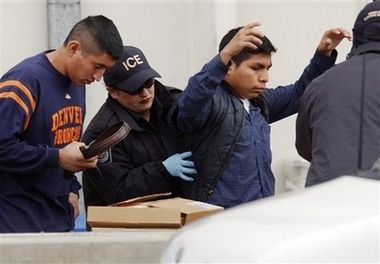
Modern Legacy of Genocide Since 1492
- Poverty for Indigenous People
- Racial Caste System still in effect (informally)
- “Illegal Immigration” (Indigenous People are classified as criminals for migrating across European-colonial borders.)
- Reservations
- Forced Sterilization of Indigenous Women
- Indian Schools (the most famous are the Indian Boarding Schools, but these have their origins in the missionary schools of early colonial Mexico. These school systematically exterminated Indigenous culture: languages, writing, mathematics, theology, and pride.)
- Latino/Hispanic (an attempt to whitewash the Indigenous-descent population, making them a sub-category of Spanish imperialism.)
- Manifest Destiny (the theft of Indigenous lands and parceling it out to white settlers)
- United Fruit Company and Monsanto - corporate colonialism of lands and resources
- Genocide of Mayans in Guatemala 1980s - hundreds of thousands were killed by paramilitary forces funded by the United States.
- Bush Doctrine – pre-emptive invasion in the name of “saving them with Democracy”.
- IMF, WTO, World Bank - this “triad” oversees (read: strong-arms) the world economy on behalf of “The West”. These institutions are run by Europeans to “develop” non-white nations, charging them huge interest on debts loaned out with numerous “structural reform” strings attached.
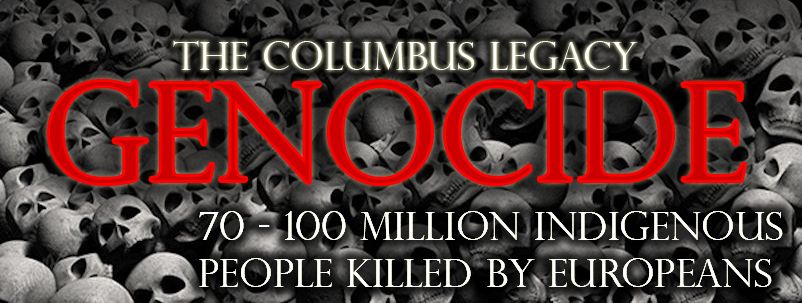
Conclusion
Columbus Day is more than just a holiday celebrating a man who merely “mistreated the natives”. “Mistreatment”, “depopulation”, and other euphemisms for genocide, torture, rape, and enslavement do an injustice to the horror story that is The Columbus Genocide Legacy. Columbus Day honors the architect of 521 years of continuous genocidal actions against Indigenous People.
To criticize Columbus Day merely on the notion that he did not “discover” an already-inhabited hemisphere is inadequate. The real significance of Columbus Day lies in the fact he established the Indigenous Holocaust Formula, leading to the extermination of 70 million to 100 Million Indigenous People and the theft of Indigenous lands.
This genocide paved the way for Europeans to acquire lands for “free”. The enormous wealth of the Western Hemisphere transformed Europe into a wealthy continent, and provided white settlers with “opportunities” which they would not have otherwise found back inside Europe.
Today, “Corporate Conquistadors” continue to plunder the world on behalf of “The West” (European-descent people), plundering natural resources from those who need them the most, and imposing poverty-producing conditions on struggling economies.
The cultural genocide continues today as well. A current proposal is underway to construct a “Museum of the American Latino” which plans to glorify Spaniards and their colonial past, while subsuming Indigenous-descent people under the categories of Hispanic/Latino, as a way of erasing their identity and voices.
In the words of Noam Chomsky, “The conquest continues”.
Sources:
Genocide: A Comprehensive Introduction
American Indian Contributions to the World
1491: New Revelations on the Americas
Year 501: The Conquest Continues by Noam Chomsky
Pagans In The Promised Land: Decoding The Doctrine of Discovery
Visit the Nican Tlaca Facebook page for more information
NICAN TLACA UNIVERSITY
NICAN TLACA UNIVERSITY - 1492: Columbus and the Legacy of Genocide
Friday, September 13, 2013
COMMENTARY: Teacher's strike in Mexico City
Almost all of our strikes and protests tend to be failures in the long-term. Why is this? Because while our people have the proper "instincts" to protest over temporary issues (labor issues, "immigration reform", police brutality), we do not have the proper NICAN TLACA MENTALITY (knowledge of history, identity, colonialism, genocide, false solutions) to go beyond temporary outbursts of anger and fight for long-term, structural change.
We show up, yell, and go home. Nothing changes.
We are reactive instead of proactive. We wait for something bad to happen, then react. And our reactions always take place within a EUROCENTRIC mindset: white people frame the issues, they propose the solutions, we beg them for "reforms" to our exploitation, they may (or may not) give us small crumbs, we are grateful, and nothing changes overall.
Only when we combine the "protest outrage" with a Nican Tlaca Mentality (education on our history, identity, European Colonialism) will we ever have a chance to make serious changes.
Only when we invoke our Nican Tlaca history, our Nican Tlaca identity in our protests, our chants, and the solutions will we gain serious traction in throwing off 500 years of European Colonialism.
Until then, we chant with half-baked Marxist slogans (European philosophy), narrow Capitalist goals ("we just want to work as your slaves"), and with White Supremacist slave-labels ("Latinos/Hispanics") that kill our Indigenous identity and hence, rights to our lands and our resources.
We have to learn our Nican Tlaca history. We will then reclaim our Nican Tlaca identity. And only then will we know what the hell we are protesting for, instead of being made fools every time we go out and protest using the white man's slogans, fabricated history, and loaded dice.
Otherwise, we will end up with thousands of people in the streets, with no clear sense of our Nican Tlaca past, our colonized present, or our Decolonized future. This is a recipe for a very loud failure, which we have seen time and time again.
http://www.usatoday.com/story/news/world/2013/09/13/striking-teachers-mexico-city/2812289/
Monday, September 9, 2013
Background on Nican Tlaca University of Cemanahuac
Background to the Nican Tlaca University of Cemanahuac
Personal background - I grew up on the East Side of Salinas, California. My parents were migrant farm workers in the lettuce and strawberry fields of the Salinas Valley. I lived in an especially violent section of East Salinas: Garner Avenue. (Today, Garner Avenue has become one of the bloodiest streets in "the United States".)
I was able to escape Garner Avenue by attending a private Catholic junior high and high school across town in "The White Area". This private school environment provided me with the only real structure in my life. I became a star student and captain of the wrestling team. This White World was where I wanted to be, I thought. I never wanted to go back to that "disgusting Mexican world". This led to me going to a Catholic university on scholarship. All seemed well on the surface, but I always felt that this White World did not seem designed for me, a Mexican. Something was very wrong and racist with this society I was forced to live in. But I could not even articulate the problem, much less the solution.
1993 - In college, my roommate was President of the campus Mecha club. While I got to meet several "famous Chicanos", I noticed that none of them had any kind of serious historical knowledge, much less any real future vision or cultural plan. Lots of chest-thumping and nostalgia for the 70's, but little knowledge about civilizations, achievements, or any kind of ideology that wasn't Eurocentric. I myself didn't know any better at the time.
1996 - First saw Mexica Movement's web page (original version)
At first, I didn't understand the "Indigenous" nature of the page, but I liked the call for a "think tank" that would serve our interests. I put the page to the side and continued down the flawed path of "Chicano culture". I had no idea as to how rich our Indigenous Civilizations really were.
Late 90's thru early 2000's: Traveled around the world, meeting British, Jewish, African Diaspora, German, Italian, Greek, Arab, Australians, New Zealand Maori, and many other peoples. These meetings stimulated questions in myself as to my own identity, for which I had few answers. For some weird reason, it was when I met White South Africans ("Afrikaaners") that I really began to realize the power of having your own language, your own history, and your own culture.
A painful moment was when I stood outside of Sir Isaac Newton's old house in London -- now a library next to Leicester Square -- and I thought to myself, "Why don't we (Mexicans) have any geniuses like this? What is it about whites that makes them superior to us?"
1998: Chicano History Group - Yahoo Groups
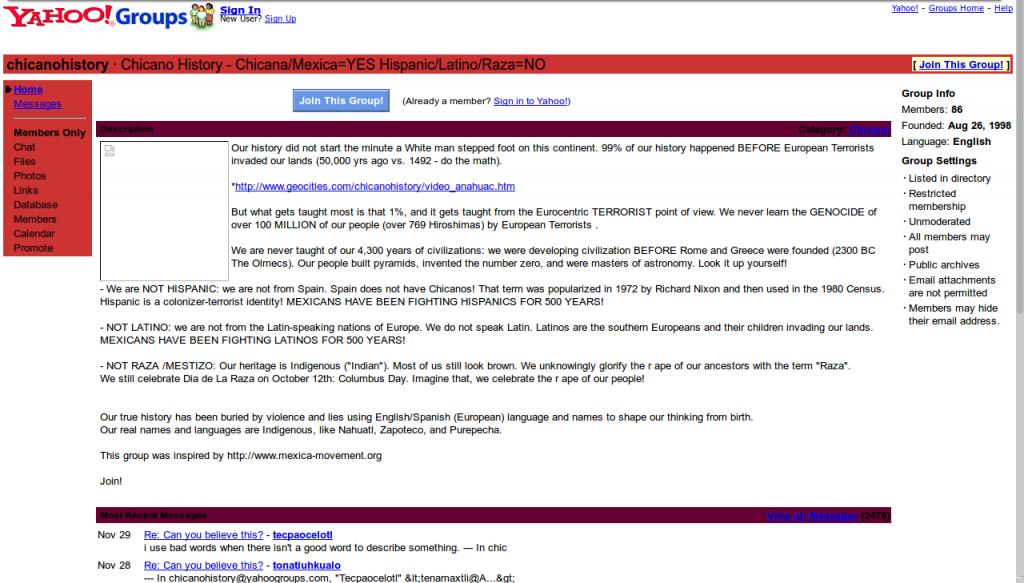
http://web.archive.org/web/20031220061349/http://groups.yahoo.com/group/chicanohistory/
In 1998, I started an online Chicano History discussion group.
In 2002, I began to change the format to promote the idea that "Chicanos are Indigenous".
1999: Discovered the book "Lies My Teacher Told Me" which shifted my views on how history was written.
2001: Discovered a book entitled "Aztecas del Norte" by Jack D. Forbes
While in a used bookstore in Grass Valley, CA, I found an old, used book that promoted the idea of Indigenous identity for Mexicans (Chicanos). The book contained a chapter called "Mexica As An Identity For Mexicans". I remembered that old Mexica Movement page I saw back in 1996 and began viewing it again, this time with fresh eyes.
2001 (August): Began speaking to Mexica Movement by phone. Many of my longtime questions were answered and I finally found the "historical narrative" I had been seeking. This narrative was supported by numerous books that I had never heard of: Daily Life of the Aztecs, Mexico Profundo, The Florentine Codex, American Holocaust, The Colonizer's Model of the World, and many more.
2002 - 2009: Chicano History page
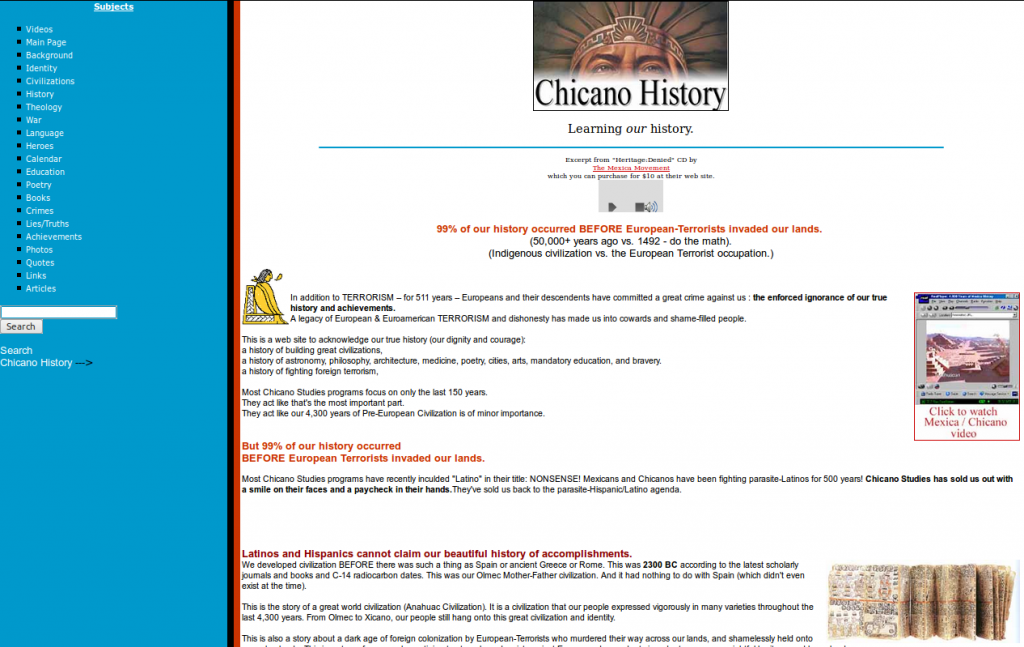
http://web.archive.org/web/20050215212540/http://www.geocities.com/chicanohistory/index2.htm
Inspired by a new Indigenous focus, I created a web site that attempted to promote our history through categories: Civilizations, Achievements, Poetry, etc.
Interesting fact: Before YouTube was a household name, this Chicano History site was already streaming numerous online videos using the RealPlayer format:
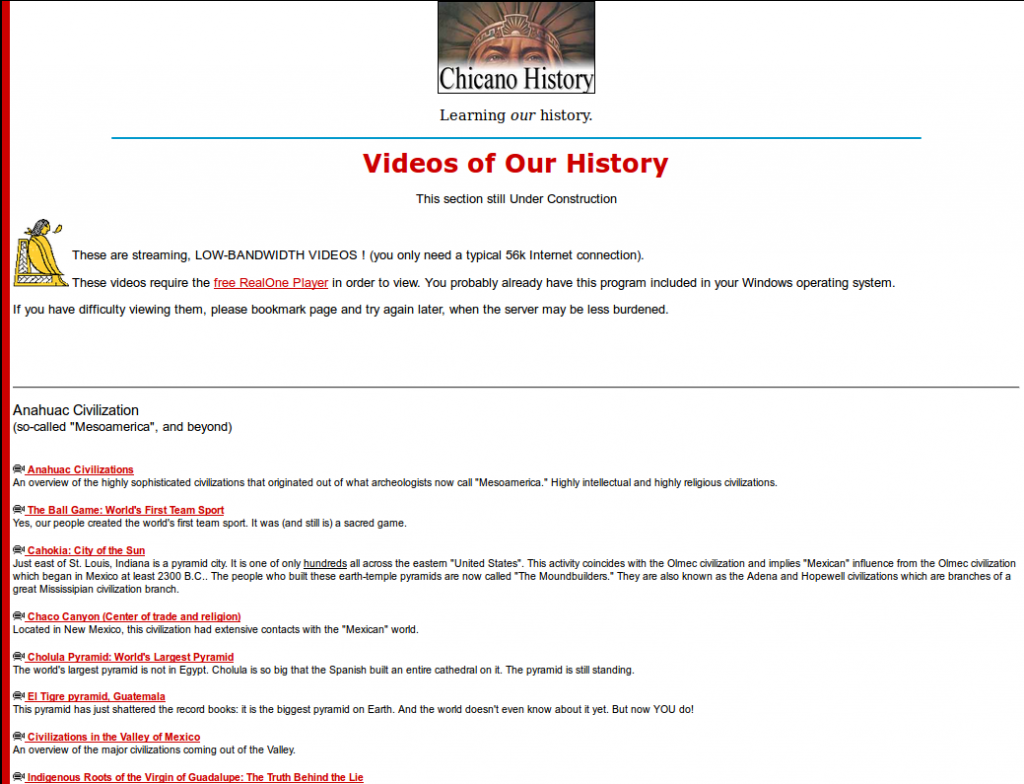
http://web.archive.org/web/20050113194358/http://www.geocities.com/chicanohistory/video_anahuac.htm
2005 - 2012 (April) - Involvement with Mexica Movement
- Confronted the Minutemen/Save Our State
http://www.youtube.com/watch?v=a_YW3bilXpU
- Confronted Lou Dobbs
http://www.youtube.com/watch?v=VS14BYsgsYc
- Filmed the MacArthur Park police brutality shootings from inside the crowd
http://www.youtube.com/watch?v=QYVWAqSRBUU
- Presentations on our history and achievements

- Wrote two articles selected as "Top 10 Stories of the Year" by Indymedia for 2007 (the Maywood Police department scandal, and the Leimert Park/Minutemen confrontation)

- Set up YouTube account (with first videos), web tracking system, PayPal account, fund raising, created "Credentials" page
- Attended protests, outreach events, and came up with poster ideas
- Took the majority of photos at events (that's why I am never seen in any photos).
- A protest confrontation with a White Supremacist made the front page of the LA Times and CNN web sites.
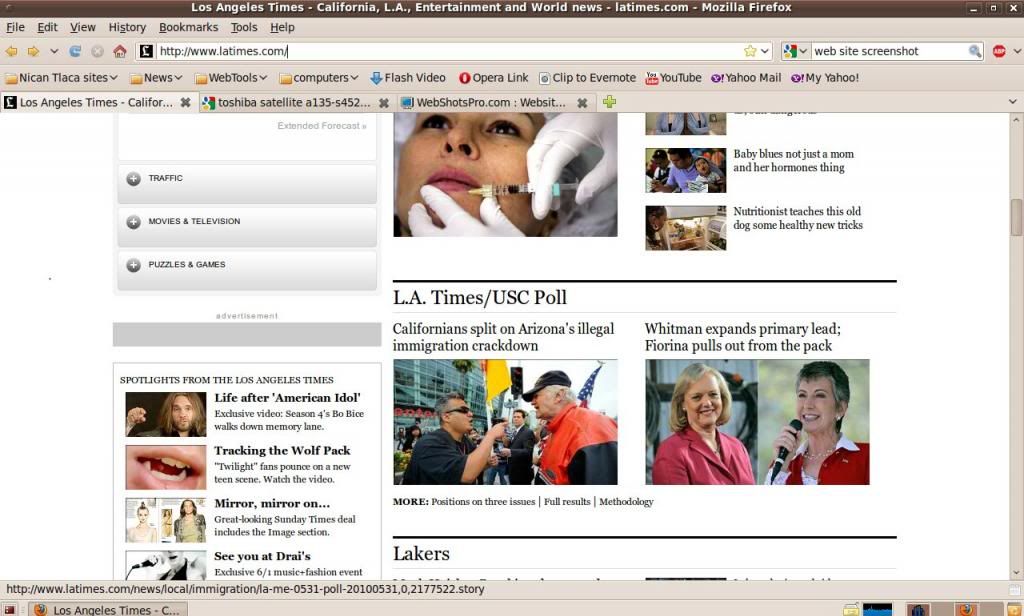
2012 (December): Nican Tlaca University of Cemanahuac

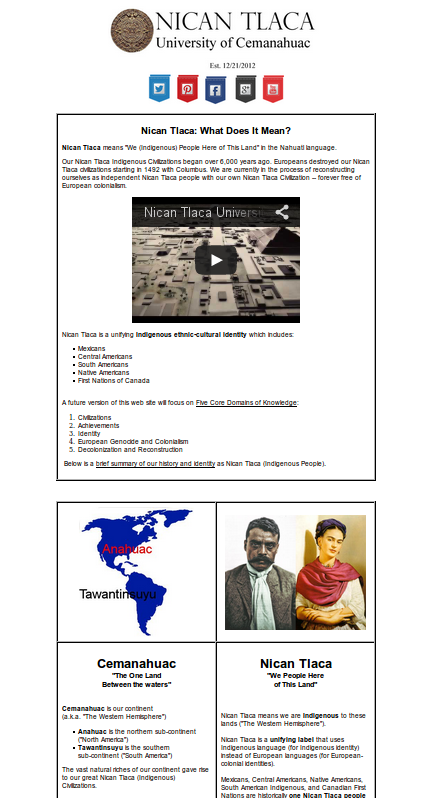
www.NicanTlaca.com
www.facebook.com/NicanTlaca
I decided to return to the spirit of my old "Chicano History" page, but this time with a "Nican Tlaca" focus. This time, with a more academic seriousness and a Decolonial direction (but Decolonization is not enough, we need to reconstruct our own Nican Tlaca Civilization to replace European Colonialism). A lot of time has been spent planning out the future direction, pedagogy, technology platform, and project ideas. This is a work-in-progress, and it is aimed at getting inside our classrooms with educational materials. We have to change the "software" in the minds of our people. Most of our people will not find this to be "sexy" because it does not involve chest-thumping, yelling on street corners, tattoos, rap music, or New Age pseudo-science.
Sunday, September 8, 2013
Visit the original Nican Tlaca University of Cemanahuac
Visit the original
Nican Tlaca University of Cemanahuac

Thursday, September 5, 2013
Learn Your Nican Tlaca History in 2 Minutes
Learn Your Nican Tlaca History in 2 Minutes
Anahuac Civilizations
Anahuac Civilizations

4,300 years ago, our earliest civilization began in the "Veracruz" region of Anahuac ("North America").
Our major northern civilizations were:
- Olmec
- Teotihuacan
- Mayan
- Toltec
- Mexica
- Mississippian
- Anasazi
Tawantinsuyu Civilizations
Tawantinsuyu Civilizations

6,000 years ago, our earliest civilization began in the Supe Valley of Peru.
Our major southern civilizations were:
- Supe Valley
- Chavin
- Moche
- Tiawanku
- Nazca
- Wari
- Inca
The intellectual and moral foundation of this project is derived from the work of Mexica Movement as well as the academic works of numerous scholars, historians, archaeologists, ethnographers, scientists, and learning theorists.
This project builds on that foundation by adding more resources: "21st-Century" learning technology as well as a focus on promoting "Nican Tlaca Cultural Literacy".
The emphasis is on decolonizing our history and liberating our people from over 500 years European Colonialism/White Supremacy.
The ultimate goal is to provide a consolidated body of knowledge from which future generations can reconstruct a new version of Nican Tlaca Civilization. This new civilization will thrive on high-tech genius, cultural courage, and total freedom from European Colonialism (which has been continuous since 1492).


